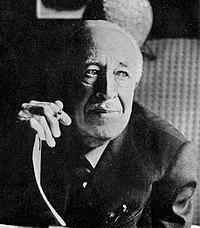Lev Kuleshov
| Lev Kuleshov | |
|---|---|

Lev Kuleshov
|
|
| Born |
Lev Vladimirovich Kuleshov 13 January [O.S. 1 January] 1899 Tambov, Russian Empire (now Russia) |
| Died | 29 March 1970 (aged 71) Moscow, Soviet Union (now Russia) |
| Occupation | Film director, screenwriter |
| Years active | 1916–1943 |
Lev Vladimirovich Kuleshov (Russian: Лев Влади́мирович Кулешо́в; 13 January [O.S. 1 January] 1899 – 29 March 1970) was a Russian and Soviet filmmaker and film theorist, one of the founders of the world's first film school, the Moscow Film School. People's Artist of the RSFSR (1969).
Lev Kuleshov was born in 1899 into an intellectual Russian family. His father Vladimir Sergeevich Kuleshov was of noble heritage. He studied art in the Moscow School of Painting, Sculpture and Architecture, despite his own father's disapproval. He then married a village schoolteacher Pelagia Alexandrovna Shubina who was raised in an orphanage, which only led to more confrontation. They gave birth to two sons: Boris and Lev. At the time Lev was born, the family became financially broke, lost their estate and moved to Tambov, living a modest life. In 1911 Vladimir Kuleshov died; three years later Lev and his mother moved to Moscow where his elder brother was studying and working as an engineer. Lev Kuleshov decided to follow the steps of his father and entered the Moscow School of Painting, although he didn't finish it. In 1916 he applied to work at the film company led by Aleksandr Khanzhonkov. He produced scenery for Yevgeni Bauer's pictures, such as The King of Paris, For Happiness and others. With time Kuleshov became more interested in film theory. He co-directed his first movie Twilight in 1917. His next film was released under the Soviet patronage.
During the 1918-1920 he covered the Russian Civil War with a documentary crew. In 1919 he headed the first Soviet film courses at the National Film School. Kuleshov may well be the very first film theorist as he was a leader in the Soviet montage theory — developing his theories of editing before those of Sergei Eisenstein (briefly a student of Kuleshov). Among his other notable students were Vsevolod Pudovkin, Boris Barnet, Mikhail Romm, Sergey Komarov, Porfiri Podobed, Vladimir Fogel and Aleksandra Khokhlova who became his wife. For Kuleshov, the essence of the cinema was editing, the juxtaposition of one shot with another. To illustrate this principle, he created what has come to be known as the Kuleshov Effect. In this now-famous editing exercise, shots of an actor were intercut with various meaningful images (a casket, a bowl of soup, etc.) in order to show how editing changes viewers' interpretations of images. Another one of his famous inventions was creative geography, also known as artificial landscape. Those techniques were described in his book The Basics of Film Direction (1941) which was later translated into many languages.
...
Wikipedia
